“In both cases you see a Labor government coming into power with the spectre of escalating energy prices and the risk of stagflation,” says the Monash University politics professor.
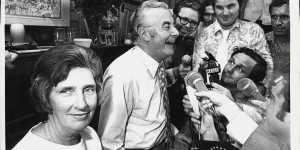
Gough and Margaret Whitlam after the 1972 federal election.Fairfax Media
Recalling the spirit of the times five decades ago,Strangio says:“When Whitlam came to power Australia had gone through 1950s and ’60s with a sense of confidence and even complacency – themes famously explored in his bookThe Lucky Country. There was a sense that prosperity would continue uninterrupted.”
. The price of oil quadrupled and the confounding new phenomenon of stagflation emerged. In Australia,inflation jumped from 6.5 per cent in 1972 to 15.3 per cent in 1975. Unemployment doubled from 2.6 to 4.9 per cent.
“What was going on was not supposed to happen – you were not supposed to have rising unemployment and inflation at the same time,” Strangio says.
Yet that’s exactly what happened,and it transformed the way Australians thought about themselves and their political leaders. “There was a sense of confusion,a degree of chaos,a loss of faith in the governing class,” Strangio says. “We came out of it a much more chastened,less confident society.”
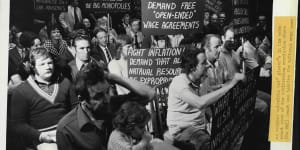
Rising inflation fuelled demands for rising wages in the 70s.Fairfax Media
The sense of drift was mirrored in Britain and the United States.
“It is a crisis that strikes at the very heart and soul and spirit of our national will,” Carter said. “We can see this crisis in the growing doubt about the meaning of our own lives and in the loss of a unity of purpose for our nation.”
The economic tumult of the ’70s ushered in the neoliberal era of small government,as Britain and the US turned to Margaret Thatcher and Ronald Reagan respectively to repair their national economies. Neoliberalism arrived somewhat later in Australia,and in a moderated form,with the election of the Hawke government in 1983.
The economic and energy challenges faced by Australians this winter are not yet as catastrophic as those of the 1970s. It’s too soon to know whether they will transform society in the long term.
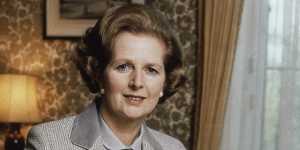
The economic and energy crises of the 1970s paved the way for Margaret Thatcher’s Conservative Party to seize power in the United Kingdom.AP
However,after the past week,the immensity of those challenges is undeniable. The era of COVID-19 lockdowns and border closures may be over,but the nation faces another winter of discontent as consumer prices soar,interest rates rise and the energy market struggles to meet demand.
In the words of Treasurer Jim Chalmers,the country faces a “perfect storm” of simultaneous spikes in gas prices,electricity prices and petrol prices.
In a grim statement two weeks ago, warned:“Apocalyptic rises in energy prices threaten chaos for industry and pain for households.”
Explaining the factors behind the crisis,Willox said:“The immediate pressures are from outages at old coal plants,consequent high gas demand for power,and the collapse of a mid-size gas retailer. But beyond these acute pressures lies the pull of international coal and gas prices,which are unprecedentedly high in the wake of the invasion of Ukraine.”
And the upshot? “Households will feel the punch from higher default electricity prices from July,and more pain is coming for all.”
Willox’s statement was as prophetic as it was alarming. On Wednesday,the Australian Energy Market Operator took unprecedented market intervention by electricity power network.
Speaking at an emergency press conference that night, pleaded with his state’s residents to minimise their use of non-critical electricity in the peak evening hours.
“This is a result of a number of our coal-fired power stations not working when we need them to,” he said.
“The number of the generators that were expected to be working tonight have not come on. It shows exactly why we need a plan to modernise our electricity system,but in the meantime,we need to make sure that our coal-fired power stations are working when we need them to.”
In Victoria,the Andrews government insisted that the state had sufficient energy supply but warned Victorians they faced a potential gas shortage next winter.
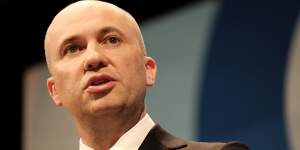
NSW Treasurer Matt Kean issued a rare call for his state’s residents to limit their use of electricity at night-time.Oscar Colman
The crisis is leading experts to rethink long-held views about the role of the government and the private sector in determining how the energy market works. Saul Eslake,a former chief economist of ANZ Bank,says although it runs against his “core beliefs”,Australia’s eastern states may need to emulate Western Australia’s policy of a domestic gas reservation.
He would usually oppose such heavy-handed intervention,but extraordinary times call for remarkable measures.
“It’s hard to justify why Australia should be paying record prices and experiencing rationing so that companies that don’t pay much tax can sell gas at extraordinarily high prices overseas,” Eslake says. “It suggests the rules of the game need to be changed.”
The chaos in the electricity market this week coincided with panic on the sharemarket.,the worst single day fall since the onset of the pandemic two years ago.
The sell-off reflected global fears of a return to a ’70s-style period of “great inflation”. As well as soaring gas and electricity prices,the cost of basic foods is exploding too – from $12 iceberg lettuces to $9 for a cabbage at the Sydney Markets.
Brian Sammut,a third-generation Sydney farmer,told theHerald this week.
“The problem is all around the board. Everything’s expensive.”
Sarah Hunter,a senior economist at KPMG,says:“In the 1970s the world was experiencing shocks not dissimilar to what we’re seeing today ... I do think it’s appropriate to describe what’s happening as stagflationary.”
In the United States,,urging policymakers not to play down the potential economic chaos that could unfold if they didn’t get the settings right.
“The current inflation regime is closer to that of the late 1970s than it may at first appear,” Summers and co-authors from the International Monetary Fund concluded in a new research paper published this week.
If you take today’s methods for calculating inflation and apply them to the old data,Summers found the inflation of the 1970s and early ’80s actually peaked at 11.4 per cent in the United States. That’s less than 3 percentage points higher than its current rate in the US.
Describing the current US inflationary conditions as the worst the country has faced since 1979,Summers foresees doom on the horizon. “The Fed’s current policy trajectory is likely to lead to stagflation,with average unemployment and inflation both averaging over 5 per cent over the next few years – and ultimately to a major recession,” he wrote recently inThe Washington Post.
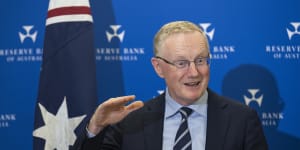
Philip Lowe made a rare appearance on 7:30 this week.Getty
Anyone doubting we live in dramatic times needed only to tune into the ABC on Tuesday night. Leigh Sales,soon to depart the presenter’s chair,was not indulging in hyperbole.
It was the first time since 2010 – when Lowe’s predecessor Glenn Stevens sat down withSunrise host David Koch – that an RBA governor had sat down for a TV interview. The sit-down came a week after the RBA raised the official cash rate to 0.85 per cent,its highest level since September 2019.
Lowe had previously issued guidance that he did not expect rates to rise until 2024,an error he has since conceded was “embarrassing”.
Eslake says Lowe’s highly unusual appearance,on7.30,showed he knew he needed to explain to Australians why the RBA had pivoted so quickly to raising rates.
“Even the financial markets have been surprised by how quickly the RBA has turned around,” Eslake says. “His remarks appeared to be addressed to those who took the Reserve Bank at face value when it said it would keep rates at record lows until 2024.”
In the interview with Sales, by the year’s end,significantly above the 6 per cent forecast by the RBA just weeks earlier.
“That’s a very high number,and we need to be able to chart a course back to 2 per cent to 3 per cent inflation. I’m confident we can do that,but it’s going to take time.”
Lowe said that could require the cash rate to rise to 2.5 per cent,although he would not say how long it would take to get there.
“At each of our meetings,we’ll be deciding how fast we need to go and,indeed,how far we need to go,” he said.
While he sees clear connections to the 1970s,historian Paul Strangio cautions against taking the comparisons too far – especially in the Australian context. “The economic pressures look much more modest now,” he says. He points out that no one is forecasting domestic inflation to rise nearly as high as it did under Whitlam.
He adds that stagflation,while disturbing,is something policymakers have a better grasp on than they did five decades ago,when it was an entirely new concept.
“In the Whitlam era,Labor lacked the intellectual resources to manage the crisis. There was intense internal conflict within the government about what to do when confronting an unprecedented situation. I don’t imagine that will happen here with the new Albanese Labor government. It has more intellectual know-how,it has discipline,it has experience in government.”
Eslake agrees,saying that no one expects inflation to remain alarmingly high for years at a time as it did in the Whitlam and Fraser era. “Unemployment is a lot lower,and while it may go up,no one is expecting it to go up to historically high rates like in the 1970s,” he says.
He adds another important advantage:Australia now has an independent Reserve Bank with a defined inflation target of 2 to 3 per cent.
To say things were worse in the past,of course,is not to say they are easy today. Winter is only just beginning,and Australia’s economic and energy dilemmas are not going away any time soon.
Cut through the noise of federal politics with news,views and expert analysis from Jacqueline Maley..